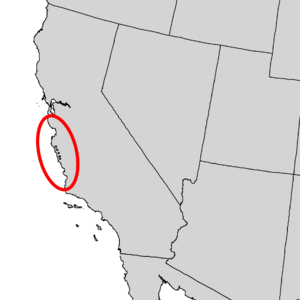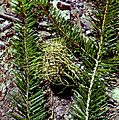Santa Lucia fir facts for kids
Quick facts for kids Santa Lucia fir |
|
|---|---|
 |
|
| Conservation status | |
| Scientific classification | |
| Genus: |
Abies
|
| Species: |
bracteata
|
 |
|
| Abies bracteata native range | |
 |
|
| Close-up of natural range of Abies bracteata | |
The Santa Lucia fir (also called the bristlecone fir) is a very special and rare tree. Its scientific name is Abies bracteata. Many people think it is the rarest fir tree in North America, and maybe even the whole world! This tree only grows in a small area. You can find it on steep slopes and in rocky canyons. These places are in the Santa Lucia Mountains in the Big Sur area. This is on the central coast of California, in the United States.
Contents
Where the Santa Lucia Fir Lives
Scientists believe the Santa Lucia fir might have grown in more places a long time ago. However, there is no clear fossil proof of this. Today, this unique tree only lives in a few small spots. These spots have conditions similar to those from a very long time ago. This might be because the climate has changed over many years.
How Fires Affect the Fir
This fir tree often grows in steep, rocky areas. These spots help protect the trees from fires. The trees usually grow at elevations between 2,000 and 5,000 feet (about 610 to 1,524 meters). The Santa Lucia fir has thin bark, which means it can easily be damaged by fire. Because of this, large groups of these trees are always found near high cliffs or in deep, rugged canyons. These locations help prevent dead leaves and branches from building up under the trees. This also helps to limit how strong fires can become.
Places Where the Fir Grows
Today, the Santa Lucia fir grows in a few scattered areas. These are all within the Santa Lucia Mountains, along the Pacific Slope of California. You can find four main groups of these trees. They are near the Ventana Double Cone and Kandlbinder Peaks, Junipero Serra Peak, Cone Peak, and along the Monterey / San Luis Obispo County line. One group is found along San Carpóforo Creek on the Hearst Ranch. The group furthest from the ocean is about 13 miles (21 km) inland. It was found in Anastasia Canyon, near the Arroyo Seco River and Tassajara Hot Springs.
Most of these fir trees grow on slopes that face north or northeast. You rarely find them below 1,700 feet (about 518 meters) in elevation. If they do grow at lower elevations, they are always at the bottom of a large canyon. In these canyons, cold air sinks and helps the trees grow well. The lowest group of trees is found at 600 to 900 feet (about 183 to 274 meters) near Ventana Camp. This camp is on the Big Sur River. It is at the bottom of a 300-foot (91 meter) deep canyon. This area is often foggy and has redwood trees.
The northernmost Santa Lucia fir tree was found in 1927. It was at 750 feet (about 229 meters) elevation on Skinners Ridge. This is east of the North Fork of the Little Sur River. We don't know if this tree survived later fires.
When the Fir Was First Found
The first known sample of the Santa Lucia fir was collected in 1831 or 1832. It was found by either Thomas Coulter or David Douglas. They probably collected samples from Cone Peak, west of Mission San Antonio. Both sent their samples to England. However, Coulter's sample was the first to be named bracteata. This name is now commonly used for the species.
Growing the Fir Tree
The Santa Lucia fir is a popular tree for gardens and parks. You can find it in many arboretums (places where different trees are grown). It grows best in a mild Mediterranean climate. This means it gets a lot of rain in winter and very dry summers. People have not been able to successfully grow it in the eastern United States. However, many groups of these trees are growing well in Europe.
What the Santa Lucia Fir Looks Like
This tree is usually 66 to 115 feet (about 20 to 35 meters) tall. It has a slender, spire-like shape, like a tall, narrow pyramid. The bark is thin and reddish-brown. It has wrinkles, lines, and small bumps filled with sticky resin. The branches of the tree point downwards.
The leaves look like needles. They grow in a spiral pattern around the branch. But they twist at their base to spread out on either side of the branch. They form two rows that point slightly forward, with a 'v' shape above the branch. The leaves are hard and stiff. They have a sharp, pointed tip. Each leaf is about 3.5 to 6 cm long and 2.5 to 3 mm wide. On the underside of the leaves, there are two bright white bands. These bands are made of tiny pores called stomata.
The flowers appear in early May. The cones are oval-shaped and 6 to 9 cm long. They can be up to 12 cm long if you include the long parts called bracts. These cones ripen and release winged seeds from late August to October. The cones of the Santa Lucia fir are different from other firs. They have very long, spreading, yellow-brown bristles. These bristles are 3 to 5 cm long. The male cones, which produce pollen, are about 2 cm long. They release their pollen in the spring.
Historical Uses
The sticky resin from the tree's trunk was used as incense. Early Spanish missions used it for this purpose.
Images for kids
See also
 In Spanish: Abeto de Santa Lucía para niños
In Spanish: Abeto de Santa Lucía para niños



